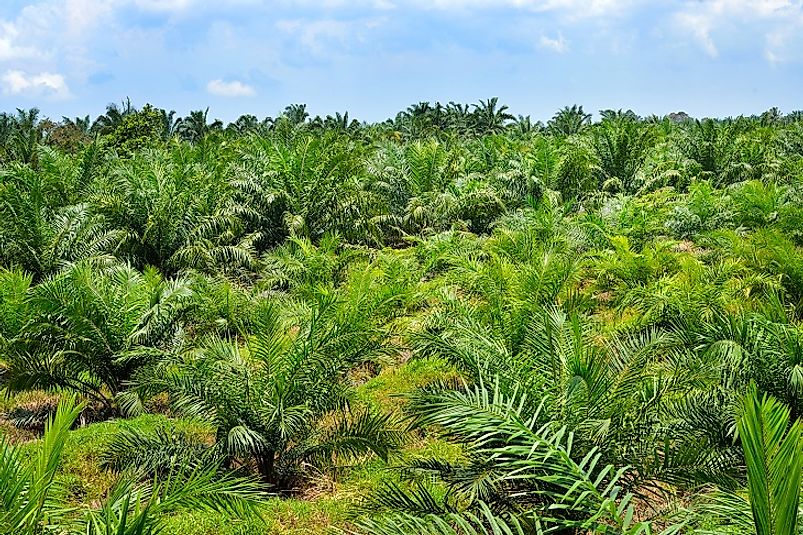How Is The Palm Oil Industry Destroying Wildlife and Their Habitats?

5. Commercial Importance of Palm Oil
Palm oil is an edible vegetable oil derived from the mesocarp of the fruits of the oil palm plants, primarily the Elaeis guineensis (African oil palm). Two other species of oil palm plants, the Elaeis oleifera and the Attalea maripa, are also used to extract palm oil. Palm oil is popularly used as cooking oil, salad oil or in preparing mayonnaise. The oil is also a source of antioxidants which are important ingredients of health and beauty products. The fact that the high content of saturated fatty acids in palm oil keeps it solidified at room temperature in temperate regions, is utilized for the widespread use of this oil as a butter, lard, or trans fat replacement. Palm oil is also used for producing biodiesel and the waste products of palm oil processing is also treated for use as biofuel. Though scientific research is lacking, palm oil is often used as an antimicrobial ointment as part of traditional medical practices. In 2012, Indonesia and Malaysia, the world’s largest producers of palm oil, reaped a benefit of nearly $40 million USD by exporting palm oil. Around 50 million tons of palm oil is produced annually and 40-50% of household products in major European and North American countries uses this oil. As per the estimates of the Food and Agriculture Organization of the United Nations, the global demand of palm oil is estimated to triple its present demand by 2050.
4. Unsustainable Vegetable Oil Production
Today, there is a hue and outcry being hear around the world regarding the unsustainable nature of palm oil production. There are allegations that vast areas of ecologically significant rainforest habitat in the countries of Malaysia and Indonesia is being cleared out to make space for palm oil plantations. Numerous indigenous species inhabiting these forests, including the Sumatran rhinoceroses, the orangutans, the Sumatran elephants, and the Bornean pygmy elephants, are losing their homes and getting killed indiscriminately at the hands of merciless poachers. The unsustainable nature of palm oil production in these countries is also speeding up climate change. Vast tracts of rainforest with commercially invaluable timber and undergrowth is being burnt down for palm oil cultivation. This is loading the air above with huge volumes of greenhouse gases, further warming up the Earth's environment. It is also believed that this unsustainable palm oil cultivation is bringing misery to the locals who are benefiting very little from this industry which is largely run primarily by large-scale corporations often employing cheap labor including children in palm oil production.
3. Species and Areas Most Affected
One of the animals that has been used an icon to spread the message against unsustainable palm oil production is the keystone species of the Indonesian and Malaysian rainforests, the orangutan. These animals are of vital importance in the ecosystem as many species of seeds are dispersed with the help of the orangutans. Over the last two decades, these animals have lost over 90% of their homeland and every year 1,000 to 5,000 of these animals are treacherously killed by poachers as they become more exposed in the absence of the secure shelter of their native forests. The orangutans are not the only species affected by this widespread disaster but are only used as ambassadors to represent the story of all other heavily suffering animals and plants of the rainforest habitats. Today, the Sumatran tiger and the Sumatran orangutan are both critically endangered with only a few surviving individuals. Most other species of this habitat are also in the “threatened” list of the International Union for the Conservation of Nature and, if the unsustainable palm oil production continues at this present rate, soon these species will become completely extinct.
2. Public Outcry and Government Regulation
Environmental groups, conservationists and concerned public have constantly lobbied over the years in an attempt to trigger a shift from unsustainable practices of palm oil production to sustainable ones. In 2013, the palm oil trader, Wilmar International, under pressure from Greenpeace, agreed to a 100 percent zero-deforestation agreement. In 2014, public protests led to the labeling of palm oil products by the European Union to allow the consumers to make their own choices. The labeling of specific oils has also been made mandatory in the U.S. since 1976. The issue of unsustainable palm oil production has also been highlighted by widespread press and media coverage and organizations like the World Wide Fund for Nature, and celebrities like Leonardo DiCaprio, have also increased awareness of the destructive effects of unsustainable palm oil production.
1. Sustainable Methods and Alternatives
Palm oil is an important part of a large number of household products with very few good alternatives to replace its position. Thus rather than stopping palm oil production altogether, there is a need to ensure it is produced in a sustainable manner. In 2004, the Roundtable on Sustainable Oil (RSPO) was created with members belonging to environmental groups, palm oil production companies and manufacturers using palm oil as an ingredient in their products. The RSPO established international standards on sustainable palm oil production and allowed the products using palm oil generated from sustainable means (labelled as Certified Sustainable Palm Oil) to carry the RSPO trademark. However, the higher costs of sustainable palm oil reduces the demand of these products in the market necessitating an even better solution to this problem. Though sustainable palm oil production appears to be elusive at present, there are good chances that with proper government regulations and public awareness, we might be able to solve the environmental crisis associated with this commodity in the years to come.











